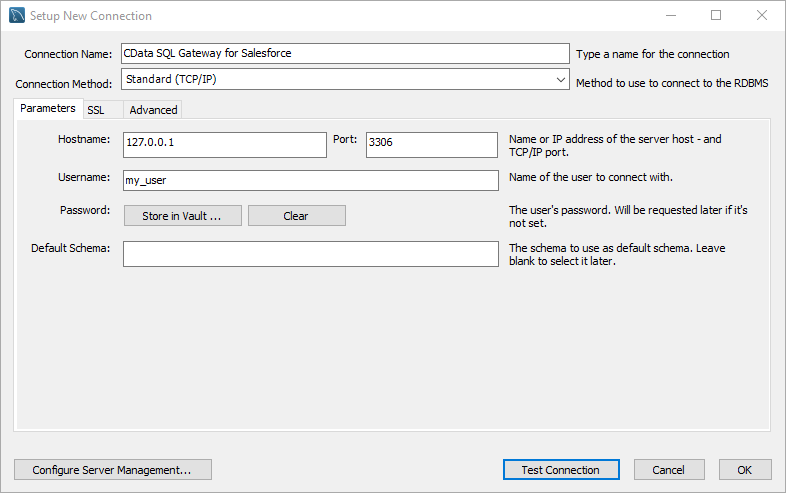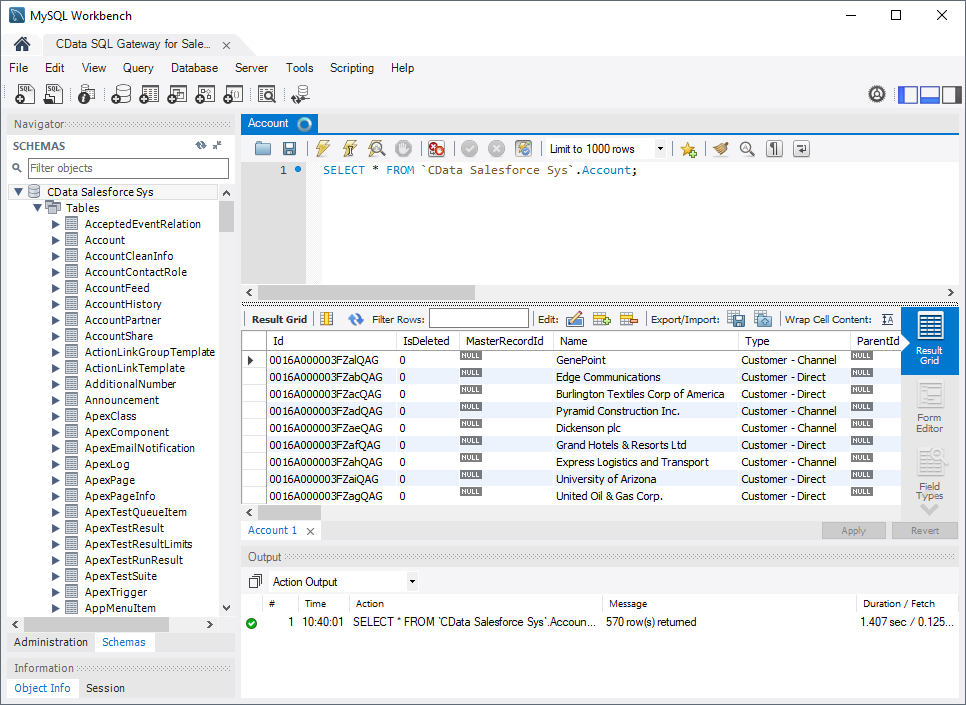Discover how a bimodal integration strategy can address the major data management challenges facing your organization today.
Get the Report →How to Query Google Data Catalog Data in MySQL Workbench
Execute MySQL queries against live Google Data Catalog data from MySQL Workbench.
You can use the SQL Gateway from the ODBC Driver for Google Data Catalog to query Google Data Catalog data through a MySQL interface. Follow the procedure below to start the MySQL remoting service of the SQL Gateway and work with live Google Data Catalog data in MySQL Workbench.
Connect to Google Data Catalog Data
If you have not already done so, provide values for the required connection properties in the data source name (DSN). You can use the built-in Microsoft ODBC Data Source Administrator to configure the DSN. This is also the last step of the driver installation. See the "Getting Started" chapter in the help documentation for a guide to using the Microsoft ODBC Data Source Administrator to create and configure a DSN.
Google Data Catalog uses the OAuth authentication standard. Authorize access to Google APIs on behalf on individual users or on behalf of users in a domain.
Before connecting, specify the following to identify the organization and project you would like to connect to:
- OrganizationId: The ID associated with the Google Cloud Platform organization resource you would like to connect to. Find this by navigating to the cloud console.
Click the project selection drop-down, and select your organization from the list. Then, click More -> Settings. The organization ID is displayed on this page.
- ProjectId: The ID associated with the Google Cloud Platform project resource you would like to connect to.
Find this by navigating to the cloud console dashboard and selecting your project from the Select from drop-down. The project ID will be present in the Project info card.
When you connect, the OAuth endpoint opens in your default browser. Log in and grant permissions to the application to completes the OAuth process. For more information, refer to the OAuth section in the Help documentation.
Configure the SQL Gateway
See the SQL Gateway Overview to set up connectivity to Google Data Catalog data as a virtual MySQL database. You will configure a MySQL remoting service that listens for MySQL requests from clients. The service can be configured in the SQL Gateway UI.

Query Google Data Catalog from MySQL Workbench
The steps below outline connecting to the virtual Google Data Catalog database created in the SQL Gateway from MySQL Workbench and issuing basic queries to work with live Google Data Catalog data.
Connect to Google Data Catalog through the SQL Gateway
- In MySQL Workbench, click to add a new MySQL connection.
- Name the connection (CData SQL Gateway for Google Data Catalog).
- Set the Hostname, Port, and Username parameters to connect to the SQL Gateway.
- Click Store in Vault to set and store the password.
- Click Test Connection to ensure the connection is configured properly and click OK.

Query Google Data Catalog Data
- Open the connection you just created (CData SQL Gateway for Google Data Catalog).
- Click File -> New Query Tab.
- Write a SQL query to retrieve Google Data Catalog data, like SELECT * FROM `CData GoogleDataCatalog Sys`.Schemas;

With access to live Google Data Catalog data from MySQL Workbench, you can easily query and update Google Data Catalog, just like you would a MySQL database. Get started now with a free, 30-day trial of the CData ODBC Driver for Google Data Catalog and the CData SQL Gateway.






